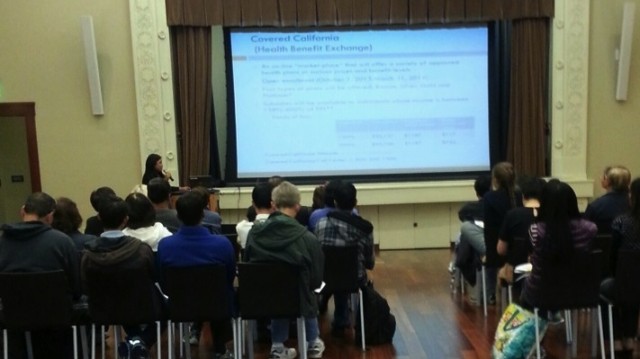The Filipino Youth Coalition, the community organization leading Filipino outreach in the Bay Area, started out as a youth service provider for Filipino-American high school students. But since open enrollment for Covered California began, the organization has had to remake itself into a health insurance education resource for all ages.
“There’s a lot of work to be done,” said Sarah Gonzalez, executive director of the coalition. “We get so many calls to make presentations, and we can only do so much. The resources are so limited.”
Gonzalez has recently resorted to paying out-of-pocket for transportation to and from presentations, as well as for refreshments, which -- although not mandatory -- are customary at Filipino gatherings.
Open enrollment will continue until March 31, 2014. But outreach workers are working under the pressure of the Dec. 15 deadline, which is the last day to enroll in order to receive coverage beginning Jan. 1. After that, uninsured individuals may incur a federal penalty.
Through its partnership with Asian Americans Advancing Justice, the only Asian and Pacific Islander community organization to receive a grant from Covered California, the Filipino Youth Coalition secured a small grant, which advocates said would be inadequate to fund the entire effort over the next five months.
But for outreach specialists like Gonzalez, delivering presentations and setting up information tables at events is worth the extra work. “At every presentation, the response is awesome,” she said. “It’s just, ‘Tell us what to do. Tell us where to sign.’”
By going through these familiar sources of information, including community centers, clinics, and churches, Covered California hopes to overcome the language barrier that had been identified as a major deterrent in applying for insurance in the past, said Iyanrick John, senior policy analyst at Asian and Pacific Islander American Health Forum, an advocacy group that closely studies health care in the Asian and Pacific Islander community.
As part of this “culturally sensitive” strategy, Covered California has pushed vigorously for resources to be delivered in native languages. Fact sheets and call lines are available in Tagalog, the primary Filipino dialect, as well as 11 other non-English languages.
“One of the aspects of the Affordable Care Act is that everybody must have equal access to get health insurance through the marketplace,” John said. “Covered California has done a pretty good job at that.”
Despite increased language access, both educators and enrollees struggle with the program’s criteria for qualifying for benefits. Certified outreach workers said those benefits were not thoroughly covered -- if at all -- in their three-day training conducted before the Oct. 1 launch. And educators found that they could not answer all enrollees’ questions like: Are children of undocumented immigrant parents covered but the parents not? Or, how are subsidies classified?
To better prepare for upcoming events, educators are regularly tuning in to informational webinars hosted by Covered California.
Recognizing the difficulties in signing up minority communities since the Oct. 1 launch, Covered California is ramping up its outreach.
Officials posted a series of video advertisements to YouTube on Oct. 17 in different Asian languages, though awareness about them remains low. The Tagalog version received just 145 views after nine days on the web.
Not everything can be done online. John explained that older, especially first-generation, immigrants prefer to get information through in-person assistance or via ethnic media, including newspapers or radio.
Some popular Asian TV spots and radio stations have already started airing advertisements in multiple languages.
Specific to the Filipino community, Tagalog, English and a mix of the two will be the focus languages in Covered California’s print advertisement running in November.
“Reaching out to communities with culturally-sensitive information delivered in their languages will be vital to our mission of expanding health care coverage in this state,” said Peter Lee, Covered California executive director, in an Oct. 21 press release announcing the launch of an Asian-language ad campaign.
This month, the state will expand advertising to paper mail, billboards, transit signs and other outdoor media, increasing awareness on the streets, where it is lacking.
To effectively distribute the additional resources, the program will continue to certify more educators. As of late last month, more than 4,200 potential enrollment counselors still awaited certification.
